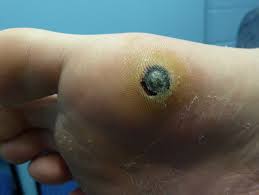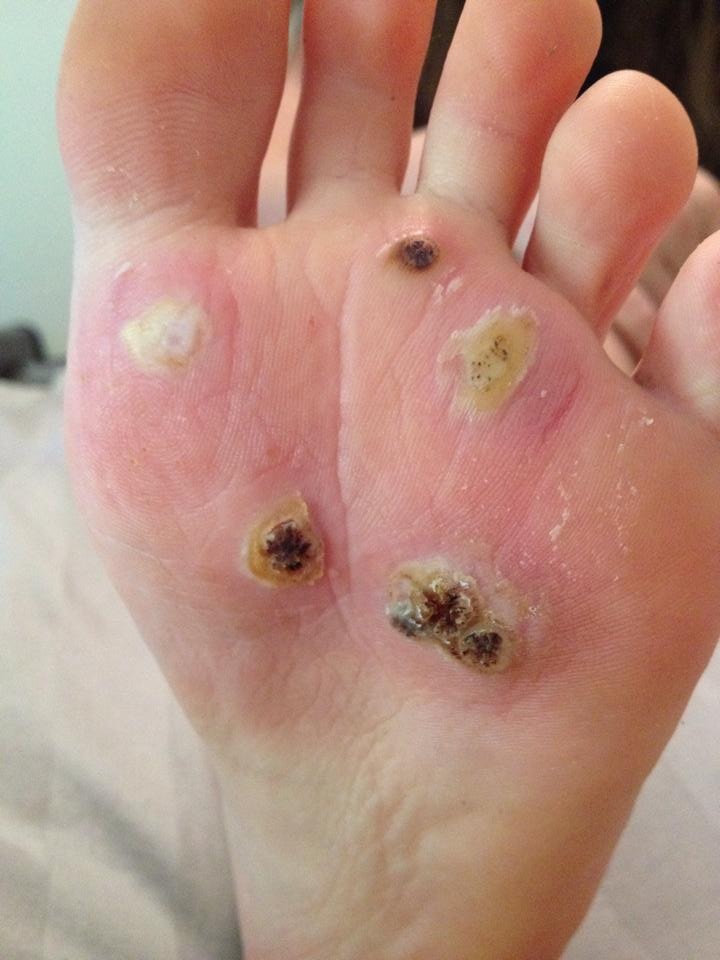Planters warts (foot warts) are callus-like growths found on the soles of feet, caused by the strain of one of the 120 different types of HPV (human papilloma virus). Plantar warts are one of the 4 types of warts namely common, flat, plantar, and genital warts. As can be seen from the picture of plantar warts below, they are generally found in those areas of the foot where most pressure and friction is exerted when walking and running. All age groups can get infected with the virus causing planters warts; they are however most commonly found in children between ages 12-16.


Infection with the virus occurs when the skin of feet that have small cuts or cracks get exposed to moist surfaces in public pools, locker rooms, and showers, resulting in warts on the bottom of feet. A person can also get infected with the virus through direct contact with people who carry the virus which causes planters warts (plantar warts). Months, even years may go by before the infections manifest in planters warts. Warts usually resolve spontaneously; those planters warts that affect a person’s ability to walk, however, need treatment. In severe cases, clusters of lumps, as can be seen in the pictures of plantar warts, start to appear. Another condition that can cause pain in the heel of the foot is planters fasciitis. Plantar fasciitis is a condition most commonly associated with sports activities that involve jumping and running. A typical symptom is a pain in the heel of the foot, and subsequently no visible sign like a wart for easy identification. Read more on planters fasciitis treatment. Warts on toes are common warts; not planters warts.
Wart Relief Is Just A Few Clicks Away!
Safe, Effective and Fast Relief from Warts
in the Comfort of Your Home!
Clear Your Skin In Weeks!
“It was unbelievable! After all these years,
my acne has cleared up…
A Natural Way To Reduce The Appearance Of Scars!
You Don’t Need Plastic Surgery to Reduce the Appearance of
Unsightly Scars caused By Acne, Burns, and Other Factors
Page Contents
Planters Warts – what are the symptoms?
Often, corns or calluses are treated medically for corns and calluses when in fact they are planters warts. As can be seen from the planters warts pictures, planters warts are small, skin-colored growths with distinct edges on the sole of the foot. Even though planters warts are self-limiting, the pressure on the pressure points in the feet (balls and heels), could at times result in warts growing inward beneath the calluses (which is caused by the frequent pressure), thus causing pain and discomfort when you walk. You can feel the lump; the pressure, however, changes warts’ appearance to flat.
Planters warts treatment
When self-help treatments fail, it’s best to seek medical advice for a proper diagnosis. Using a home remedy for warts, however, is not advised if you are in doubt as to whether it is, in fact, plantar warts. When you experience pain, should the growths change in appearance and color, you have a weak immune system due to HIV/AIDS, or you are diabetic, consult your physician. Depending on the doctor’s diagnosis, the planters wart removal options will be discussed with you.
So, how to get rid of warts on feet? The most common methods used in getting rid of plantar warts are discussed in detail in home remedies for warts. Other methods found to be effective in getting rid of plantar warts on feet include immunotherapy, electrodesiccation, and Upton’s paste. Immunotherapy is the injection of antigens into warts(s). The objective is to get the body’s immune system to reject foreign substances. Read more on getting rid of plantar warts.
Treatment for plantar warts
Electrodessication is a surgical procedure which is quite effective as a plantar warts treatment option. You will be left with a noticeable scar, however.

Upton’s paste is an acidic method where the paste is applied to the plantar wart. The paste is made up of six parts of salicylic acid and one part trichloroacetic acid in glycerine, and mixed into a stiff paste.

Using thick adhesive tape, cut a hole in the middle and apply it to the area surrounding the wart. Apply the paste to the wart and cover the wart with a second piece of tape. Keep this intact and dry. After one week shave down the wart and apply the paste again. Repeat this procedure until the wart clears.
